Section 4: Business Development12.
Business Registrations and Survival
Rates
This
measure reflects entrepreneurial activity in
the formation rate of new firms and their
ability to survive their first three years
of trading.
VAT
Registrations as a Proportion of the Stock
of Business
An
indicator of business formations is the
number of new Value Added Tax (VAT)
registrations each year as a percentage of
enterprises registered for VAT at the start
of that year.
The
figures in Table 12(a) detail VAT
registrations for manufacturing, services
and the rest of the economy, while Chart
12(a) illustrates total VAT registrations as
a proportion of business stock.
Table
12(a) indicates that registration rates in
service industries during 2001 were lower in
all regions of the UK during 2001 than in
1998. The impact of this change on the
overall UK rate has led to a drop from 13.4
per cent of business stock in 1998 to 12.0
per cent in 2001. Over the same period
registration rates in manufacturing have
also fallen in most regions, although the
declines have, in general, not been of the
same magnitude. Between 1998 and 2001
manufacturing registrations in the UK fell
from 7.9 to 7.2 per cent.
London
had the highest business formation rates in
all the years shown for manufacturing,
services, and for other industries.
The relative positions of the other
regions and countries did not change
markedly between 1998 and 2001, but it is
evident that the gap between London and the
rest of the UK has narrowed in recent years
as registrations in London have declined
more quickly than in other regions.
VAT
Registrations as a Percentage of the Adult
Population
Table
12(b)i details business VAT registration per
10,000 adults resident in each region while
Table 12(b)ii presents this information in
the form of a UK = 100 index. Chart 12(b)
compares the indices for 1999 through to
2001.
London
had the highest rate of VAT registrations
per 10,000 adults between 1998 and 2001 at
more than 160 per cent of the average for
the UK as a whole. For all years between
1998 and 2001 registrations per head were
lowest in the North East (around 20
registrations per 10,000 adults), just over
half of the rate for the UK as a whole.
The
greatest decline during this period occurred
in London, with a fall of just over 11
percentage points relative to the UK.
Registrations per head in most other
regions were reasonably steady or increased
between 1998 and 2001.
The very high registrations/population rate for London is likely be, at least in part, a result of the high concentration of business in Central London and in - commuting of workers from other regions. Business
Survival
Business
survival rates detail the proportion of
businesses remaining registered for VAT
three years after their initial
registration, the year shown in Table 12(c)
+ 3.
Survival
rates for the UK have been rising steadily
since 1994.
Three-year survival rates were nearly
60 per cent for firms first registered
during 1994, and increased during all years
to a high of just over 65 per cent for
businesses registered during 1997.
Chart 12(c) indicates that this
overall pattern has been repeated in
most of the English regions, as well as in
Wales and Scotland.
Chart
12(a) 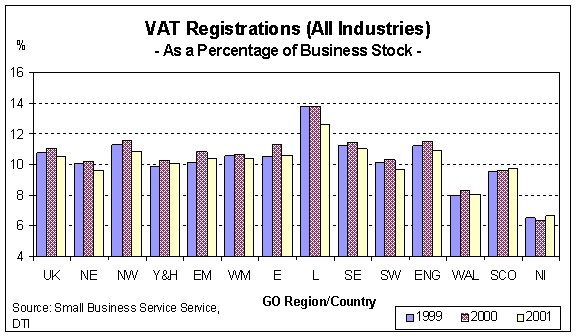
Chart 12(b)
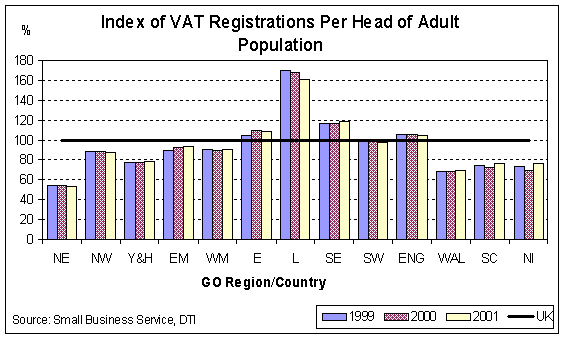
Chart 12(c)
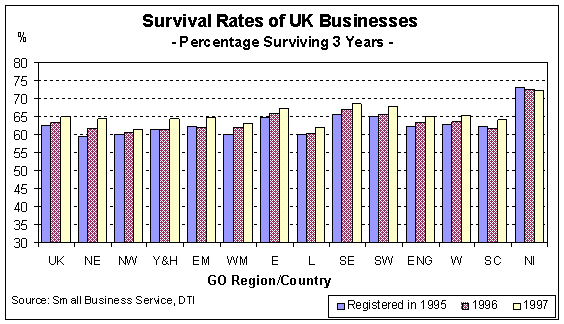
This indicates the value of the Research &
Development (R&D) activity carried out by
manufacturing and service sector firms and the
number of employee jobs in high technology
industries.
Expenditure on R&D measures the extent to which
businesses are developing and exploiting new
technology, software and ideas. R&D
activity can be a stimulant to the
competitiveness of firms within a region.
Chart 13(a) represents the value of R&D carried
out by the combined manufacturing and service
sectors as a proportion of regional GVA for
1997 to 1999.
The R&D data used in this Chart and
in Table 13(a) are taken from the Survey of
Business Enterprise Research and Development
and the regional economic accounts, both
produced by the ONS (see Definitions Section).
It is evident that R&D as a proportion of GVA was
significantly higher in the East of England
than any other region, with proportions
relatively low in the North East, Yorkshire
and the Humber, London and in Wales, Scotland
and Northern Ireland. Across regions,
expenditure on R&D was in general, higher
in the manufacturing sector than in the
services sector.
Chart 13(b) and Table 13(b) detail the proportion of employee jobs in high and medium - high technology manufacturing industries. As can be observed from these, 5.3 per cent of all employee jobs in the UK were classified as high or medium - high technology industries during 2001, a fall of just under 1 percentage point on 1998. This fall is due to two factors: a decrease of around 10 per cent in the number of UK high and medium - high tech. jobs as well as some growth in other sectors of the economy over the 1998 to 2001 period. During 2001, the West Midlands had the highest proportion of this type of job (at just under 8 per cent of all employee jobs), with the lowest in London (at 1.7 per cent). The fall in the level of high and medium – high technology jobs between 1998 and 2001 occurred in every region and country within Great Britain. The North East, East Midlands and West Midlands have been particularly affected, with decreases in the level of these jobs of 14, 15 and 16 per cent respectively.
Chart 13(a)
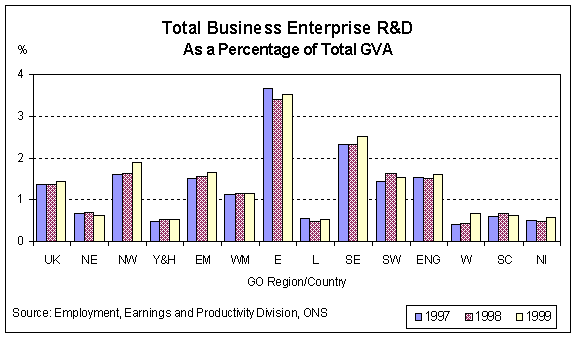
Chart 13(b)
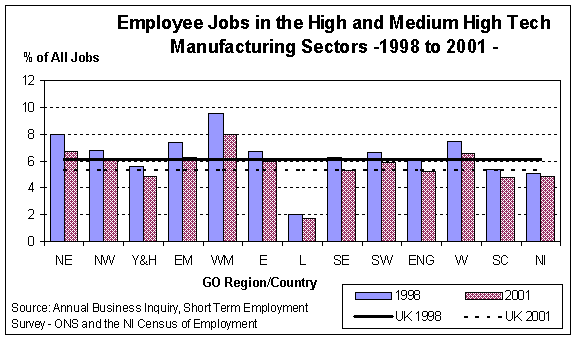
Home - Search - Site Map - Contact Us |